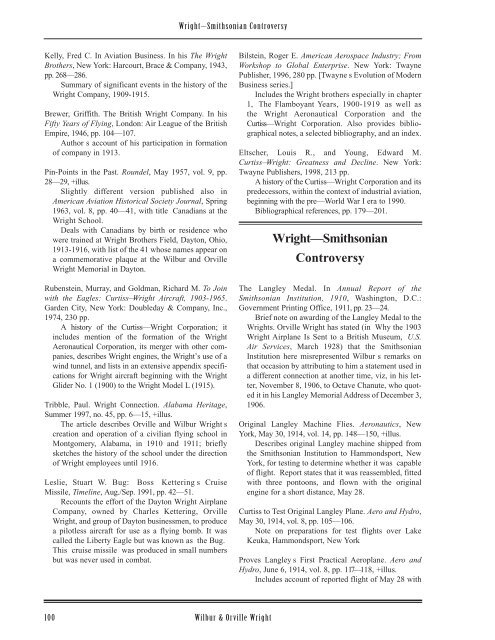Published Writings of Wilbur and Orville Wright - NASA's History Office
Published Writings of Wilbur and Orville Wright - NASA's History Office
Published Writings of Wilbur and Orville Wright - NASA's History Office
You also want an ePaper? Increase the reach of your titles
YUMPU automatically turns print PDFs into web optimized ePapers that Google loves.
Kelly, Fred C. In Aviation Business. In his The <strong>Wright</strong><br />
Brothers, New York: Harcourt, Brace & Company, 1943,<br />
pp. 268—286.<br />
Summary <strong>of</strong> significant events in the history <strong>of</strong> the<br />
<strong>Wright</strong> Company, 1909-1915.<br />
Brewer, Griffith. The British <strong>Wright</strong> Company. In his<br />
Fifty Years <strong>of</strong> Flying, London: Air League <strong>of</strong> the British<br />
Empire, 1946, pp. 104—107.<br />
Author s account <strong>of</strong> his participation in formation<br />
<strong>of</strong> company in 1913.<br />
Pin-Points in the Past. Roundel, May 1957, vol. 9, pp.<br />
28—29, +illus.<br />
Slightly different version published also in<br />
American Aviation Historical Society Journal, Spring<br />
1963, vol. 8, pp. 40—41, with title Canadians at the<br />
<strong>Wright</strong> School.<br />
Deals with Canadians by birth or residence who<br />
were trained at <strong>Wright</strong> Brothers Field, Dayton, Ohio,<br />
1913-1916, with list <strong>of</strong> the 41 whose names appear on<br />
a commemorative plaque at the <strong>Wilbur</strong> <strong>and</strong> <strong>Orville</strong><br />
<strong>Wright</strong> Memorial in Dayton.<br />
Rubenstein, Murray, <strong>and</strong> Goldman, Richard M. To Join<br />
with the Eagles: Curtiss—<strong>Wright</strong> Aircraft, 1903-1965.<br />
Garden City, New York: Doubleday & Company, Inc.,<br />
1974, 230 pp.<br />
A history <strong>of</strong> the Curtiss—<strong>Wright</strong> Corporation; it<br />
includes mention <strong>of</strong> the formation <strong>of</strong> the <strong>Wright</strong><br />
Aeronautical Corporation, its merger with other companies,<br />
describes <strong>Wright</strong> engines, the <strong>Wright</strong>’s use <strong>of</strong> a<br />
wind tunnel, <strong>and</strong> lists in an extensive appendix specifications<br />
for <strong>Wright</strong> aircraft beginning with the <strong>Wright</strong><br />
Glider No. 1 (1900) to the <strong>Wright</strong> Model L (1915).<br />
Tribble, Paul. <strong>Wright</strong> Connection. Alabama Heritage,<br />
Summer 1997, no. 45, pp. 6—15, +illus.<br />
The article describes <strong>Orville</strong> <strong>and</strong> <strong>Wilbur</strong> <strong>Wright</strong> s<br />
creation <strong>and</strong> operation <strong>of</strong> a civilian flying school in<br />
Montgomery, Alabama, in 1910 <strong>and</strong> 1911; briefly<br />
sketches the history <strong>of</strong> the school under the direction<br />
<strong>of</strong> <strong>Wright</strong> employees until 1916.<br />
Leslie, Stuart W. Bug: Boss Kettering s Cruise<br />
Missile, Timeline, Aug./Sep. 1991, pp. 42—51.<br />
Recounts the effort <strong>of</strong> the Dayton <strong>Wright</strong> Airplane<br />
Company, owned by Charles Kettering, <strong>Orville</strong><br />
<strong>Wright</strong>, <strong>and</strong> group <strong>of</strong> Dayton businessmen, to produce<br />
a pilotless aircraft for use as a flying bomb. It was<br />
called the Liberty Eagle but was known as the Bug.<br />
This cruise missile was produced in small numbers<br />
but was never used in combat.<br />
<strong>Wright</strong>–Smithsonian Controversy<br />
100 <strong>Wilbur</strong> & <strong>Orville</strong> <strong>Wright</strong><br />
Bilstein, Roger E. American Aerospace Industry; From<br />
Workshop to Global Enterprise. New York: Twayne<br />
Publisher, 1996, 280 pp. [Twayne s Evolution <strong>of</strong> Modern<br />
Business series.]<br />
Includes the <strong>Wright</strong> brothers especially in chapter<br />
1, The Flamboyant Years, 1900-1919 as well as<br />
the <strong>Wright</strong> Aeronautical Corporation <strong>and</strong> the<br />
Curtiss—<strong>Wright</strong> Corporation. Also provides bibliographical<br />
notes, a selected bibliography, <strong>and</strong> an index.<br />
Eltscher, Louis R., <strong>and</strong> Young, Edward M.<br />
Curtiss—<strong>Wright</strong>: Greatness <strong>and</strong> Decline. New York:<br />
Twayne Publishers, 1998, 213 pp.<br />
A history <strong>of</strong> the Curtiss—<strong>Wright</strong> Corporation <strong>and</strong> its<br />
predecessors, within the context <strong>of</strong> industrial aviation,<br />
beginning with the pre—World War I era to 1990.<br />
Bibliographical references, pp. 179—201.<br />
<strong>Wright</strong>—Smithsonian<br />
Controversy<br />
The Langley Medal. In Annual Report <strong>of</strong> the<br />
Smithsonian Institution, 1910, Washington, D.C.:<br />
Government Printing <strong>Office</strong>, 1911, pp. 23—24.<br />
Brief note on awarding <strong>of</strong> the Langley Medal to the<br />
<strong>Wright</strong>s. <strong>Orville</strong> <strong>Wright</strong> has stated (in Why the 1903<br />
<strong>Wright</strong> Airplane Is Sent to a British Museum, U.S.<br />
Air Services, March 1928) that the Smithsonian<br />
Institution here misrepresented <strong>Wilbur</strong> s remarks on<br />
that occasion by attributing to him a statement used in<br />
a different connection at another time, viz, in his letter,<br />
November 8, 1906, to Octave Chanute, who quoted<br />
it in his Langley Memorial Address <strong>of</strong> December 3,<br />
1906.<br />
Original Langley Machine Flies. Aeronautics, New<br />
York, May 30, 1914, vol. 14, pp. 148—150, +illus.<br />
Describes original Langley machine shipped from<br />
the Smithsonian Institution to Hammondsport, New<br />
York, for testing to determine whether it was capable<br />
<strong>of</strong> flight. Report states that it was reassembled, fitted<br />
with three pontoons, <strong>and</strong> flown with the original<br />
engine for a short distance, May 28.<br />
Curtiss to Test Original Langley Plane. Aero <strong>and</strong> Hydro,<br />
May 30, 1914, vol. 8, pp. 105—106.<br />
Note on preparations for test flights over Lake<br />
Keuka, Hammondsport, New York<br />
Proves Langley s First Practical Aeroplane. Aero <strong>and</strong><br />
Hydro, June 6, 1914, vol. 8, pp. 117—118, +illus.<br />
Includes account <strong>of</strong> reported flight <strong>of</strong> May 28 with

















